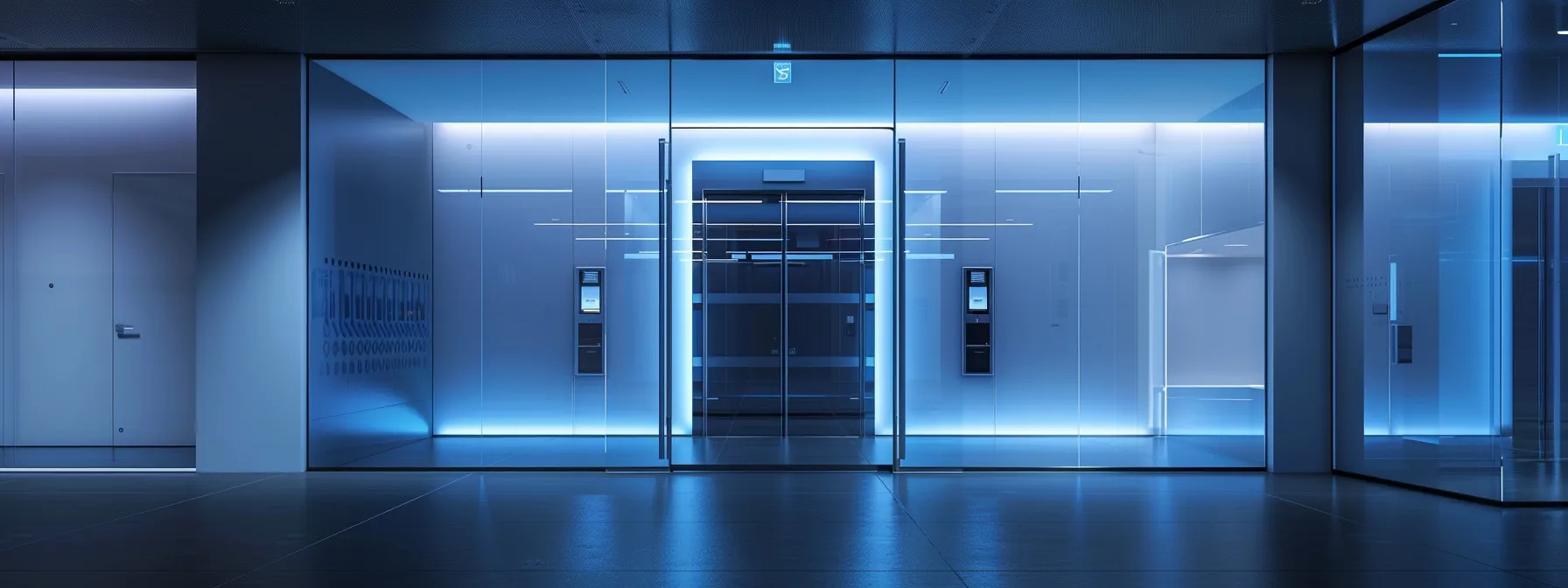Are your business premises truly secure? Access control systems offer a robust solution to protect your assets and personnel. This article explores the implementation of advanced access control measures, their benefits for business security, and emerging technological innovations. By understanding these systems, you’ll learn how to enhance your security infrastructure, address common implementation challenges, and prepare for future trends in access control technology.
Understanding Access Control Systems for Businesses

access control systems are essential for protecting critical infrastructure and managing employee access. These frameworks incorporate key components like wireless technology and card readers, integrating with payroll and elevator systems. Understanding various access control mechanisms helps businesses implement effective security measures, safeguarding assets and personnel while streamlining operations.
Definition and Importance of Access Control Systems
Access control systems define and enforce security policies, regulating who can enter specific areas within a business. These systems utilize advanced technologies such as biometrics, mobile apps, and real-time analytics to authenticate users and maintain a detailed audit trail. By integrating seamless communication between various security components, access control systems enhance overall business security while providing valuable insights into employee movement patterns and resource utilization.
Key Components of Access Control Frameworks
Access control frameworks consist of several key components that work together to create a comprehensive security system. These include readers, controllers, locks, and management software. The system authenticates users through various methods, such as card readers or biometric scanners, while the infrastructure supports seamless communication between devices. Automation features enable customized access rules, and intercom systems facilitate visitor management. Businesses can tailor these components to their specific needs, enhancing security and operational efficiency:
| Component | Function |
|---|---|
| Readers | Authenticate users |
| Controllers | Process access decisions |
| Locks | Secure entry points |
| Management Software | Oversee system operations |
Different Types of Access Control Mechanisms
Organizations implement various access control mechanisms to mitigate security risks and enhance overall protection. These mechanisms include physical, logical, and administrative controls, each serving a specific purpose in safeguarding assets and information. Physical controls, such as surveillance cameras and biometric scanners, regulate entry to premises, while logical controls manage digital access through authentication protocols and user interfaces. Administrative controls encompass policies and procedures that govern access rights and responsibilities, ensuring a comprehensive approach to security management.
Implementing Access Control Systems to Enhance Security

Implementing effective access control systems enhances business security by safeguarding assets and preventing unauthorized entry. This process involves assessing security needs, selecting appropriate systems, and integrating them with existing measures. Organizations can improve retail loss prevention and building automation by choosing the right keypads and access control solutions tailored to their specific requirements.
Steps to Assess Your Business Security Needs
Assessing business security needs involves evaluating existing infrastructure and identifying potential vulnerabilities. Organizations should analyze their physical layout, employee access patterns, and sensitive areas requiring protection. This process includes reviewing current security measures, such as smart locks and retail point-of-sale systems, to determine their effectiveness. Companies can leverage open APIs to integrate access control with existing systems, creating a comprehensive security framework. Establishing a detailed audit trail helps businesses track and monitor access events, providing valuable insights for security optimization.
Choosing the Right Access Control System for Your Organization
Selecting the appropriate access control system requires careful consideration of various factors, including the organization’s security needs, budget constraints, and existing infrastructure. Companies should evaluate cloud computing options for scalable solutions that reduce on-premises hardware expenses. When assessing commercial access systems, businesses must consider the integration of key card door locks for enhanced security and convenience. The chosen system should offer flexibility in licensing options to accommodate future growth and changing security requirements.
Integrating Access Control With Existing Security Measures
Integrating access control with existing security measures enhances overall physical security for businesses. By connecting door control systems with ADT offers and other security systems, organizations create a comprehensive protection network. This integration allows for centralized management of security protocols, enabling seamless communication between access control devices and servers. Companies can leverage this unified approach to strengthen their security posture, improve response times, and streamline operations:
| Integration Component | Benefit |
|---|---|
| Door Control Systems | Enhanced entry point security |
| ADT Offers | Professional monitoring services |
| Security Systems | Comprehensive protection |
| Servers | Centralized data management |
Benefits of Access Control Systems for Business Security

Access control systems offer significant benefits for business security, enhancing physical protection through advanced technologies like fingerprint recognition and intrusion detection systems. These solutions provide robust monitoring and reporting capabilities, utilizing computer hardware and software from providers like Brivo. Additionally, they help businesses meet compliance requirements and improve accessibility, ensuring a secure and efficient work environment.
Strengthening Physical Security With Access Controls
Access control systems significantly enhance physical security by implementing encryption, cloud access control, and smart card technologies. These systems utilize credentials to authenticate users, ensuring only authorized personnel can enter specific areas. Cloud-based solutions offer real-time monitoring and remote management capabilities, allowing businesses to maintain tight control over their premises. The integration of smart cards and biometric credentials further strengthens security measures, making it extremely difficult for unauthorized individuals to gain access:
| Security Feature | Benefit |
|---|---|
| Encryption | Protects data transmission |
| Cloud Access Control | Enables remote management |
| Smart Card Technology | Enhances user authentication |
| Biometric Credentials | Prevents unauthorized access |
Monitoring and Reporting Capabilities of Access Control Systems
Access control systems offer robust monitoring and reporting capabilities, enhancing identity management and scalability for businesses. These systems integrate with commercial key card door locks and internet access points, providing comprehensive security coverage. Advanced solutions, such as those offered by Honeywell, enable real-time tracking of entry attempts, generating detailed reports on user activity and potential security breaches. This level of monitoring allows businesses to quickly identify and respond to unauthorized access attempts, maintaining a secure environment for employees and assets.
Compliance and Regulatory Considerations
Access control systems help businesses meet compliance requirements and adhere to industry regulations. These systems facilitate the implementation of security measures mandated by standards such as HIPAA, PCI DSS, and SOX. By incorporating turnstile technology and detailed access logs, organizations can demonstrate their commitment to protecting sensitive information and physical assets. Compliance with these regulations not only enhances security but also helps businesses avoid potential fines and legal issues:
| Regulation | Access Control Requirement |
|---|---|
| HIPAA | Protect patient data access |
| PCI DSS | Secure payment card information |
| SOX | Maintain financial data integrity |
| GDPR | Ensure data privacy compliance |
Technological Innovations in Access Control Systems

Technological advancements are revolutionizing access control systems for businesses. Biometric solutions offer enhanced security through unique physical identifiers. Cloud-based access control provides flexibility and remote management capabilities. Mobile credentials leverage smartphone technology for convenient and secure access. These innovations are transforming how businesses protect their assets and manage entry points.
Overview of Biometric Access Control Solutions
Biometric access control solutions utilize unique physical characteristics to authenticate individuals, enhancing security for Connecticut businesses. These systems employ advanced technologies such as fingerprint recognition, facial scanning, and iris detection to verify identities with high accuracy. By integrating biometric readers with existing security infrastructure, organizations can significantly reduce the risk of unauthorized access and improve overall protection:
| Biometric Technology | Advantage |
|---|---|
| Fingerprint Recognition | High accuracy, cost-effective |
| Facial Scanning | Non-contact, fast authentication |
| Iris Detection | Extremely reliable, difficult to forge |
| Voice Recognition | Remote authentication capability |
The Role of Cloud-Based Access Control in Modern Security
Cloud-based access control systems revolutionize modern security for Connecticut businesses by offering scalable, flexible solutions that can be managed remotely. These systems store access data securely in the cloud, allowing real-time updates and monitoring from any location. By eliminating the need for on-premises servers, cloud-based access control reduces hardware costs and simplifies system maintenance. This technology enables seamless integration with other security measures, providing a comprehensive approach to protecting assets and personnel across multiple locations.
Mobile Credentials and Their Impact on Business Security
Mobile credentials transform business security by leveraging smartphone technology for access control. These digital keys enable employees to enter secured areas using their mobile devices, eliminating the need for physical cards or fobs. Connecticut businesses benefit from enhanced security, as mobile credentials can be quickly updated or revoked remotely, reducing the risk of unauthorized access. This technology also streamlines visitor management and improves user experience:
| Feature | Benefit |
|---|---|
| Remote Management | Instant access updates |
| Multi-Factor Authentication | Enhanced security |
| Smartphone Integration | Improved convenience |
| Visitor Management | Streamlined guest access |
Common Challenges in Access Control System Implementation

Implementing access control systems poses challenges for Connecticut businesses. Technical barriers and integration issues can hinder smooth deployment. Employee training on new systems is crucial for effective use. Managing access levels and permissions requires careful consideration to balance security and operational needs. Addressing these challenges ensures robust protection for assets and personnel.
Navigating Technical Barriers and Integration Issues
Connecticut businesses face technical barriers and integration issues when implementing access control systems. Legacy infrastructure often conflicts with modern security solutions, requiring careful planning and adaptation. System compatibility poses challenges, as new access control components must seamlessly integrate with existing security measures. Overcoming these obstacles demands expertise in both physical and digital security domains, ensuring a cohesive and effective protection strategy:
| Challenge | Solution |
|---|---|
| Legacy Infrastructure | Phased modernization approach |
| System Compatibility | Middleware integration |
| Physical-Digital Integration | Unified security platform |
| Network Security | Robust encryption protocols |
Training Employees on New Access Control Systems
Training employees on new access control systems presents a critical challenge for Connecticut businesses implementing enhanced security measures. Organizations must develop comprehensive training programs that cover system operation, security protocols, and proper credential management. Effective training ensures employees understand their responsibilities in maintaining a secure environment, reducing the risk of unintentional security breaches. By investing in thorough education and ongoing support, businesses can maximize the effectiveness of their access control systems and foster a culture of security awareness among staff members.
Managing Access Levels and Permissions Effectively
Effective management of access levels and permissions is crucial for maintaining robust security in Connecticut businesses. Organizations must establish clear policies for granting and revoking access rights, ensuring employees have appropriate permissions based on their roles and responsibilities. Regular audits of access levels help identify and rectify potential security vulnerabilities, while implementing the principle of least privilege minimizes the risk of unauthorized access. Businesses can streamline this process by utilizing role-based access control systems, which automatically assign permissions based on predefined job functions:
| Access Management Strategy | Benefit |
|---|---|
| Clear Access Policies | Consistent permission assignment |
| Regular Audits | Identify security vulnerabilities |
| Least Privilege Principle | Minimize unauthorized access risk |
| Role-Based Access Control | Automated permission assignment |
Future Trends in Access Control Systems for Businesses

Access control systems continue to evolve, incorporating advanced technologies to enhance business security. The integration of artificial intelligence is revolutionizing system capabilities, enabling predictive analytics and automated decision-making. Simultaneously, sustainability concerns are driving the development of energy-efficient and environmentally friendly access control solutions. These trends are shaping the future of security measures for Connecticut businesses.
Evolution of Security Technologies and Their Implications
The evolution of security technologies is reshaping access control systems for Connecticut businesses. Advanced artificial intelligence algorithms now enable predictive threat detection, analyzing patterns to identify potential security risks before they occur. Quantum encryption techniques are emerging to protect data transmission between access control devices, offering unprecedented levels of security against cyber threats. These technological advancements are transforming how businesses approach security, allowing for more proactive and sophisticated protection measures.
Role of Artificial Intelligence in Access Control Systems
Artificial intelligence is revolutionizing access control systems for Connecticut businesses. AI-powered algorithms analyze access patterns and user behavior, enabling predictive security measures that anticipate potential threats. These systems can automatically adjust access permissions based on real-time data, enhancing overall security while reducing the need for manual intervention. By leveraging machine learning capabilities, AI-driven access control solutions continuously improve their accuracy and effectiveness, providing businesses with cutting-edge protection against evolving security risks.
Sustainability and Green Solutions in Access Control Implementation
Sustainability is becoming a key focus in access control implementation for Connecticut businesses. Energy-efficient systems, such as those utilizing Power over Ethernet (PoE) technology, reduce electricity consumption while maintaining robust security. Manufacturers are developing eco-friendly credentials made from recycled materials, minimizing environmental impact. These green solutions not only contribute to corporate sustainability goals but also offer long-term cost savings through reduced energy usage:
- Energy-efficient PoE systems
- Eco-friendly credentials
- Reduced electricity consumption
- Long-term cost savings
Conclusion
Access control systems are vital for safeguarding Connecticut businesses, integrating advanced technologies to protect assets and manage employee access effectively. These systems offer robust monitoring capabilities, ensure compliance with regulations, and leverage innovations like biometrics and cloud-based solutions to enhance security measures. Implementing access control requires careful planning, addressing technical challenges, and providing thorough employee training to maximize system effectiveness. As security technologies continue to evolve, incorporating artificial intelligence and sustainable solutions, businesses must stay informed and adapt their access control strategies to maintain a strong defense against emerging threats.




